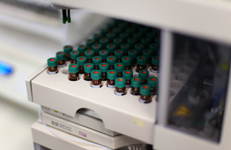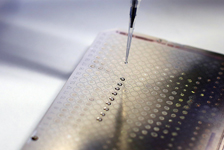wet-Lab-Techniques



Proteome Research requires ample state-of-the-art experimental techniques for protein identification and validation as well as for detailed protein structure and structure-/function characterization.
Sample Preparation:
- Generation of protein extracts from tissue
- Affinity chromatography using magnetic beads
- Anion exchange-based Stage Tip peptide fractionation
- Phosphopeptide enrichment
- Fractionated precipitation
- Cell culture
- Ultra Centrifuge (Beckman)
- Laser Microdissection & Pressure Catapulting System (P.A.L.M. )
- Fluorescence Microscope (Zeiss)
- RNA Interference
- Cytometry System FACSCalibur™ (Becton Dickinson)
Mass Spectrometry/Protein Analysis:
- Synapt G2-S (Waters)
- MALDI-ToF-MS (Bruker)
- MALDI-QIT-ToF-MS (Shimadzu)
- LC-ESI-Q-ToF-MS (Micromass)
- Online Nano-LC (Dionex)
- Online Nano-LC, inert system (Dionex)
- Surface Plasmon Resonance Spectrometer (Biacore)
- MAP II-Robot (Bruker)
- Chemical Printer (Shimadzu)
2D-Gel Electrophoresis/Separation Methods:
- 1D- and 2D- Electrophoresis units (Invitrogen, BioRad, GE Healthcare)
- UMAX scanner
- Fluorescence scanner (Fuji)
- HPLC (Agilent)
- Picking-Robot (Genomics solutions)
- Automatic Digester (Genomics solutions)
- BioCAD Sprint Perfusion Chromatography™ System (Applied Biosystems)
- Free-Flow Electrophoresis
Transcriptomics:
- High Density Microarray System (Affymetrix)
- Sensi Chip Microarray Reader (Qiagen)
- Pyrosequencer (PSQ 96) (Pyrosequencing Ltd.)
- TaqMan (Applied Biosystems)
- WAVE® DHPLC System (Transgenomic)
- ABI PRISM® 310 Single-Capillary Genetic Analyzer (Applied Biosystems)
- BioRobot8000 (Qiagen)



